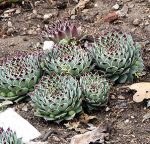
Native to the mountains of southern Europe and western Asia, this evergreen succulent perennial is a member of the stonecrop family, Crassulaceae, that also includes jade plant, kalenchoe, and Echeveria. The plant grows 4-12″ tall and forms a rosette of 50-60 thick fleshy leaves 4″ across. The leaves are often pointed, 1.5-3″ long , and may have purple tips. The rosette, often called the hen, sends out many horizontal stems that produce new plants called chicks. In summer, the “hen” produces 8-12″ tall thick stalks carrying star-shaped, red, yellow, or lavender flowers with 7-20 petals each. After flowering the “hen” dies and the “chicks” take over so that the plant appears to live on in the garden forever. Even when a plant is removed from the soil and neglected for a long period of time it will revive when planted again thus giving credence to the idea that it lives forever. Numerous cultivars are available that vary most significantly in flower and leaf color, as well as leaf shape and texture. Hens and chicks is very easy to grow and does well even with neglect as long as it does not get too much water. It is a good choice for a border, rock garden, crevices in a wall garden, and a container, as well as an edging or ground cover. Also known as such common names as common houseleek, St. Patrick’s cabbage, and Jove’s beard, the ancient Romans grew the plants on the roof tops to ward off lightning bolts thrown by Jupiter/Jove. In addition, the leave can be eaten as a salad green. The genus name, Sempervivum comes from the Latin words semper meaning always and vivus meaning living and refers to fact the plant appears to live forever. The specific epithet, tectorum, is the Latin word meaning of the roofs and refers to the custom of growing the plant on roof tops.
Type: Evergreen succulent perennial
Bloom: Star-shaped, red, yellow or lavender flowers, in summer
Size: 4-12″ H x 4-12″ W
Light: Full sun but tolerates light shade
Soil: Average (tolerates lean), dry to medium moist, well-drained; moderately salt tolerant
Hardiness: Zones 3-8
Care: Very low maintenance
Pests and Diseases: Generally healthy but susceptible to rust and crown rot
Propagation: Division of off sets, seed
Companion Plants: New Zealand flax, black mondo grass, blue fescue
Outstanding Selections:
‘Boissieri’ (bronze-tinged leaves with rusty tips)
‘Sunset’ (bright green leaves with shades of red and orange)
‘Oddity’ ( quilled margins and black tips)
‘Cobweb houseleek’ (white threads across the rosette resembling cobweb)
Photo Credit: Pamela J. Eisenberg Wikipedia